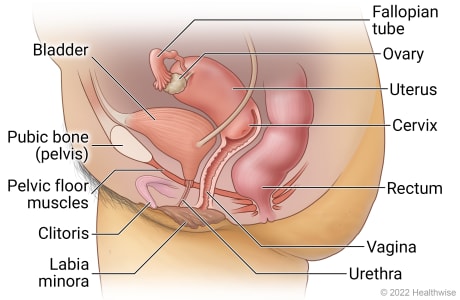Health Library
We have a vast digital library of medical information, including wellness and psychiatry topics as well as general medical topics. For more information or to schedule an appointment, don’t hesitate to call us.
Our Health Library information does not replace the advice of a doctor. Please be advised that this information is made available to assist our patients to learn more about their health. Our providers may not see and/or treat all topics found herein. Pelvic organ prolapse means that a pelvic organ—such as your bladder—has moved from its normal position and is pressing against your vagina. This can happen when the muscles and tissues that hold your pelvic organs in place get weak or damaged. Pelvic organ prolapse is common. It isn't usually a big health problem, but it can be uncomfortable or painful. It can be treated if it bothers you. And it may get better with time. More than one pelvic organ can prolapse at the same time. Organs that can be involved include the: The pelvis is the ring of bones between the hips where several organs and structures are located. The female pelvic area includes the fallopian tubes, ovaries, uterus, cervix, bladder, urethra, pelvic floor muscles, clitoris, vagina, and rectum. Pelvic organ prolapse occurs when the muscles and tissues that hold your pelvic organs in place get weak or damaged. It's often linked to pregnancy and vaginal childbirth. During pregnancy and delivery, pelvic muscles can get stretched and injured. Other causes of prolapse include aging, menopause, obesity, and frequent constipation. You may not have any symptoms. Or you may feel pressure from pelvic organs pressing against the vaginal wall. Your lower belly may feel very full, and you may feel as if something is falling out of your vagina. You may have urinary or bowel problems or pain during intercourse. Your doctor will ask you questions about your past and current health. This includes asking about your symptoms and past pregnancies. Your doctor will also do a physical exam, including a pelvic exam. And you may have other tests. Pelvic organ prolapse that doesn't cause symptoms may be found during a routine exam. You may not need or want treatment. But if symptoms bother you, you can try doing Kegel exercises and staying at a healthy weight. You can also try a pessary. Surgery may also be an option. Pelvic organ prolapse occurs when the muscles and tissues that hold your pelvic organs in place get weak or damaged. It is often linked to pregnancy and childbirth. During pregnancy and vaginal delivery, pelvic muscles can get stretched and injured. If the muscles don't recover, they can't support your pelvic organs as well. Anything that puts pressure on your belly can also increase your risk for pelvic organ prolapse. Things that can put pressure on your belly include obesity, frequent constipation, a long-lasting (chronic) cough, and frequent heavy lifting. Pelvic organ prolapse can occur when you're young. But it's more likely to happen as you get older. And it's more common after menopause. It also tends to run in families. You may not have any symptoms. Or pressure on your vagina may cause discomfort or problems with your pelvic organs. Symptoms may include: Symptoms are worse when you stand, jump, or lift. They usually are relieved if you lie down. Call your doctor to schedule an appointment if: Watchful waiting is a wait-and-see approach. If you have been diagnosed with pelvic organ prolapse and you don't have symptoms, or if you have mild symptoms that aren't interfering with your daily activities, you may wish to try watchful waiting. In many cases, pelvic organ prolapse doesn't cause symptoms and doesn't need treatment. If you have symptoms, such as a feeling of pressure in your vagina, schedule an appointment with your doctor. A prolapse of a pelvic organ can be hard to diagnose. Pelvic organ prolapse that doesn't cause symptoms may be found during a routine exam. You may be aware that there's a problem, but you might not be sure of the exact location or cause. If your doctor thinks you may have an organ prolapse, your doctor will ask you questions about your past and current health. This includes questions about your symptoms and your history of pregnancies and other health problems. Your doctor will also do a physical exam, including a pelvic exam. Tests may be done to find out more about the prolapse, particularly if it's causing problems with bladder or bowel function. These may include urodynamic tests and imaging tests, such as ultrasound or MRI. Decisions about treating pelvic organ prolapse are based on which organs have prolapsed and how bad your symptoms are. You may not need or want treatment. If your symptoms are mild, you may be able to relieve them at home. If these changes don't help, you can ask your doctor to fit you with a pessary. It's a removable device that you can put in your vagina to support areas of prolapse. Surgery may be an option if symptoms don't get better with other treatments or if you prefer surgery over other treatments. But you may want to delay surgery if you plan to get pregnant in the future. The strain of childbirth could cause the prolapse to come back. Home treatment can relieve the discomfort of pelvic organ prolapse. It can also help to keep prolapse from getting worse. If you have pain and discomfort from pelvic organ prolapse that isn't helped by nonsurgical treatment and lifestyle changes, you may want to think about surgery. Which type of surgery depends upon which organs are involved, how bad your symptoms are, and what other medical conditions you have. Also, your surgeon may have experience with and prefer to do a certain procedure. The goals of surgery are to relieve your symptoms and restore the normal functioning of your pelvic organs. Types of surgeries used to correct pelvic organ prolapse may include: These surgeries can help treat your symptoms. But some people may have symptoms of urinary incontinence after surgery. Your doctor may do an exam to check if urinary incontinence could be a problem for you after surgery. If the exam shows that it could be a problem, surgery to correct stress urinary incontinence can be done at the same time as surgery to repair prolapse. Current as of: May 5, 2025 Author: Ignite Healthwise, LLC Staff Current as of: May 5, 2025 Author: Ignite Healthwise, LLC Staff Clinical Review Board This information does not replace the advice of a doctor. Ignite Healthwise, LLC disclaims any warranty or liability for your use of this information. Your use of this information means that you agree to the Terms of Use and Privacy Policy. Learn how we develop our content. To learn more about Ignite Healthwise, LLC, visit webmdignite.com. © 2024-2025 Ignite Healthwise, LLC.Pelvic Organ Prolapse
What is pelvic organ prolapse?
Female pelvic anatomy

What causes it?
What are the symptoms?
How is it diagnosed?
How is pelvic organ prolapse treated?
Cause
Symptoms
When to Call a Doctor
Watchful waiting
Exams and Tests
Learn more
Treatment Overview
Self-Care
Learn more
Surgery
Learn more
Related Information
Credits
Clinical Review Board
All Ignite Healthwise, LLC education is reviewed by a team that includes physicians, nurses, advanced practitioners, registered dieticians, and other healthcare professionals.
All Ignite Healthwise, LLC education is reviewed by a team that includes physicians, nurses, advanced practitioners, registered dieticians, and other healthcare professionals.



